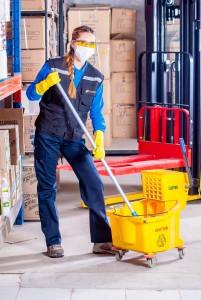 Why should we pay attention to housekeeping at work?
Why should we pay attention to housekeeping at work?Effective housekeeping can eliminate some workplace hazards and help get a job done safely and properly. Poor housekeeping can frequently contribute to accidents by hiding hazards that cause injuries. If the sight of paper, debris, clutter and spills is accepted as normal, then other more serious health and safety hazards may be taken for granted.
Housekeeping is not just cleanliness. It includes keeping work areas neat and orderly; maintaining halls and floors free of slip and trip hazards; and removing of waste materials (e.g., paper, cardboard) and other fire hazards from work areas. It also requires paying attention to important details such as the layout of the whole workplace, aisle marking, the adequacy of storage facilities, and maintenance. Good housekeeping is also a basic part of accident and fire prevention.
Effective housekeeping is an ongoing operation. By keeping the work area consistently tidy can show the company are serious about keeping employees and others safe. Periodic “panic” clean ups are costly and ineffective in reducing accidents.
Poor housekeeping can be a cause of accidents, such as:
To avoid these hazards, a workplace must “maintain” order throughout the working day.
Effective housekeeping results in:
A good housekeeping program plans and manages the orderly storage and movement of materials from point of entry to exit. The plan also ensures that work areas are not used as storage areas by having workers move materials to and from work areas as needed.
Housekeeping order is maintained not achieved. This means removing the inevitable messes that occur from time to time and not waiting until the end of the shift to reorganize and clean up. A good housekeeping program identifies and assigns responsibilities for the following:
Don’t forget places such as shelves, basements and boiler rooms that would otherwise be overlooked. The orderly arrangement of operations, tools, equipment and supplies is an important part of a good housekeeping program.
The final addition to any housekeeping program is inspection. It is the only way to check for deficiencies in the program so that changes can be made. Walker Health and Safety Services can carry out workplace inspection.
Contact Walker Health and Safety Services should you require further information.